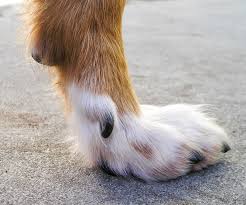The Dew Claw is a toenail located on the inside part of their front leg. Some dogs and breeds also have Dew Claws located on the inside of their rear legs. In fact, some claws actually have double Dew Claws on some legs. When a dog has a double claw on a leg, it’s called polydactyl. Some dogs don’t have Dew Claws at all.
Dew Claws located on the inside of their rear legs. In fact, some claws actually have double Dew Claws on some legs. When a dog has a double claw on a leg, it’s called polydactyl. Some dogs don’t have Dew Claws at all.
Why is it called Dew Claw
When a dog walks through the grass in the morning before the dew has vanished, the Dewclaw skims along the top of the grass. This is how this claw received its name.
Do Dew Claw have a purpose
So since Dew Claws don’t actually touch the ground are they just a useless appendage. In fact, they do have a number of purposes. Many dogs will use their Dewclaw like a thumb to hold onto bones or toys. Other dogs have figured out how to use their Dew Claws to scratch their noses or the corner of their eye. Some can even scratch the inside of their ears.
Front Dew Claw can also be used for stability when a dog is on slippery terrain such as ice or makes a high-speed turn or change of direction.
Check out this video to see this in action.
There are also breeds of dog that can climb a tree much like a cat. They use their Dew Claws to grasp the tree bark as they climb. This includes breeds such as the Basenji and the Catahoula Leopard Dog.
Around 40,000 years ago there existed an animal called the Miacis. This animal was actually a tree dweller and later developed to hunt on the ground. This animal is, in fact, an ancestor of the modern day dog. Dew Claws on dogs are the result of evolution from this animal.
Dew Claw trimming
It is important to remember to clip the Dew Claws just like the other toenails. As the Dew Claws have no contact with the ground they are unable to be worn down naturally. See this article for tips on clipping your dog’s nails. Because of the position of the claw, left untrimmed, it can curve down so much it becomes ingrown into the pad. This can cause an infection.
Check out this video to see what happens when a Dew Claw grows back into the pad and how to trim it.
Left untrimmed, the quick will also grow longer. This will make it harder to keep the toenails properly trimmed. The quick is the blood vessel inside the nail. If you clip the quick the nail will bleed. With regular clipping, the end of the quick will dry out and it will recede.
Dog breeds with rear Dew Claws
Breeds like the Great Pyrenees and Saint Bernard quite commonly have rear Dew Claws. It is thought that they use these to work in snow or rough terrain. This aids them by giving them better stability as they run over the rough ground or make sharp turns. For certain breeds, they are required to have rear DewClaws in dog shows to meet the breed standard.
Other breeds with rear Dew Claws include;
- the Portuguese Sheepdog – single or double
- Icelandic Sheepdog – double preferred
- Cao Fila de Sao Miguel – single
- Estrela Mountain Dog – single or double
- East Siberian Laika
- Anatolian Shepherd Dog – double
- Beauceron – double; they should be close to the foot to provide a larger weight-bearing surface
- Catalonian Sheepdog – double and joined together
- Briard – double; close to the ground
Dew Claw problems
In some circumstances, there is the risk of an injury to a Dew Claw. Most often the Dew Claw is attached to the bone and tucked in so this is less likely. Some dogs have Dew Claw that is attached to muscle and not supported by bone. In this case, the Dew Claw often dangles loosely and has a higher likelihood of getting caught on something and tearing. Without the support of the bone, the Dew Claw is fairly useless to the dog anyway. The vet may determine in that case that it is best to remove the claw as a precaution. Often this is done at the time a dog is being desexed rather than needing to do surgery just to remove the Dew Claw.
Should Dew Claws be removed
As front dewclaws serve an important purpose, they should not be removed unless there is a very good reason to do so. In some circumstances, dog’s dewclaw may be severely injured and the vet may decide that to remove it is the best course of action. In extremely rare cases a dew claw can develop a cancerous tumor and removal, under those circumstances, would be in the dog’s best interest.
Related Posts
